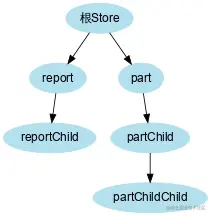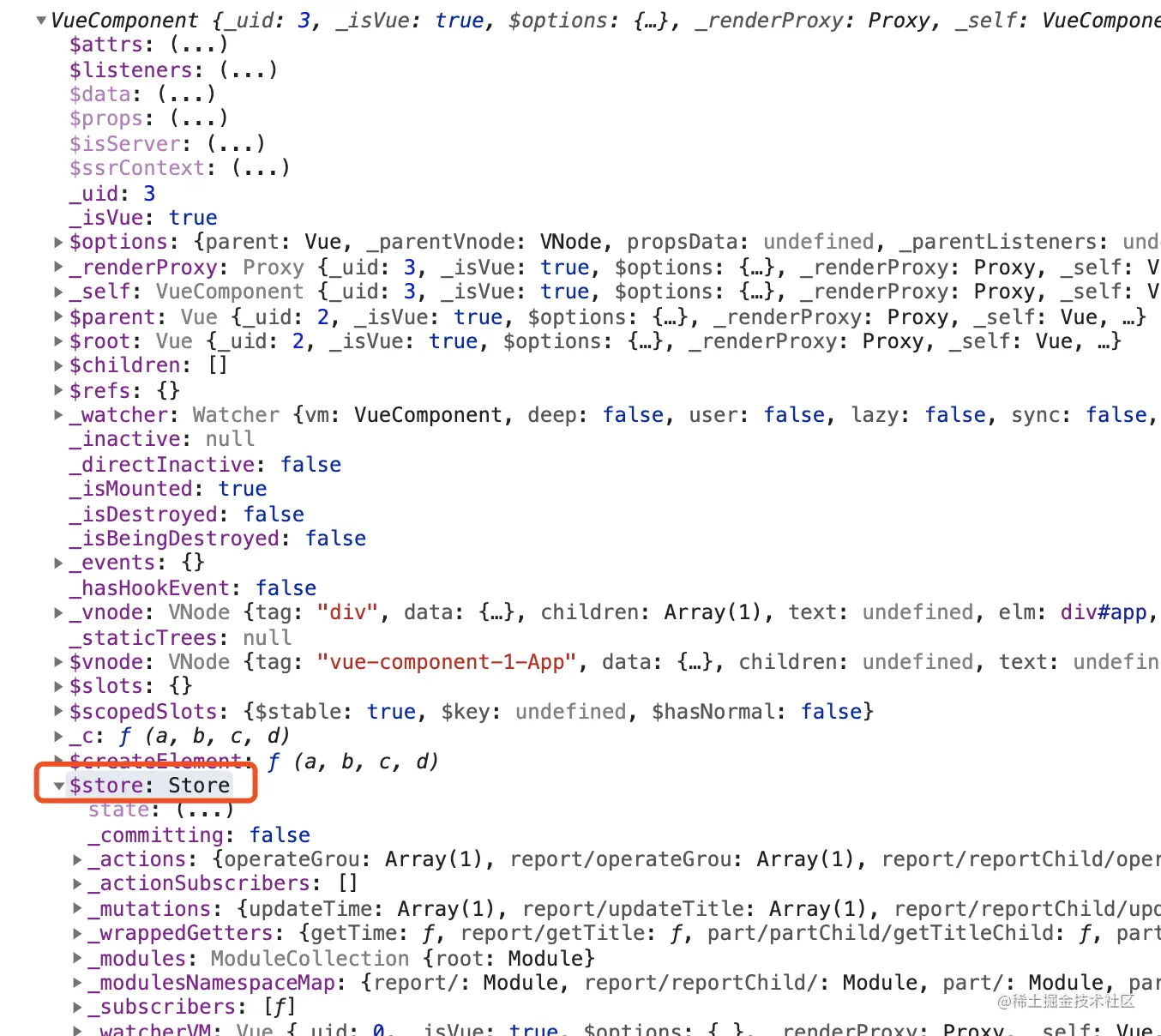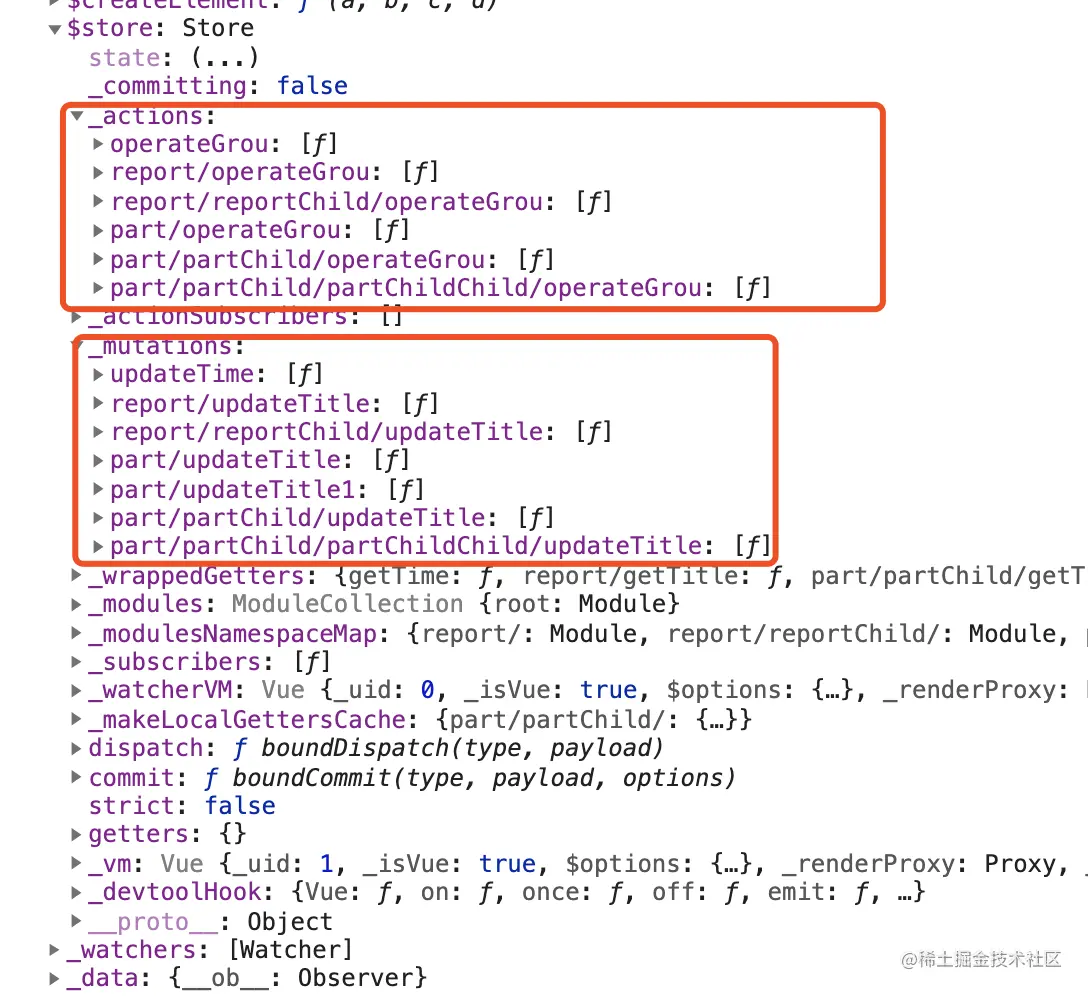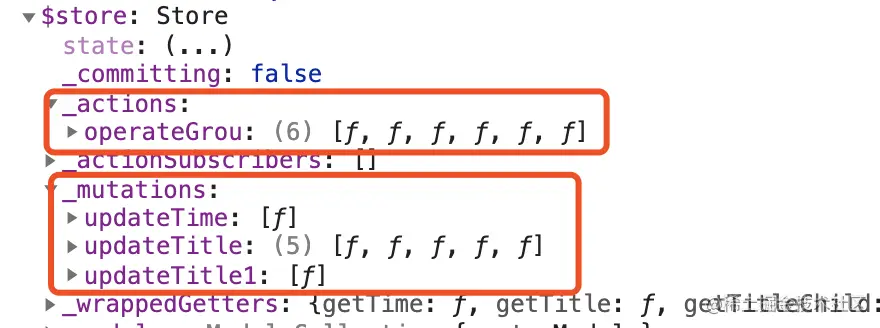背景
Vuex 是一个专为 Vue.js 应用程序开发的状态管理模式。Vuex 是专门为 Vue.js 设计的状态管理库,以利用 Vue.js 的细粒度数据响应机制来进行高效的状态更新。如果你已经灵活运用,但是依然好奇它底层实现逻辑,不妨一探究竟。
Vue 组件开发
我们知道开发 Vue 插件,安装的时候需要执行 Vue.use(Vuex)
import Vue from 'vue'import Vuex from '../vuex'
Vue.use(Vuex)
复制代码
通过查看 Vue API Vue-use 开发文档,我们知道安装 Vue.js 插件。如果插件是一个对象,必须提供 install 方法。如果插件是一个函数,它会被作为 install 方法。install 方法调用时,会将 Vue 作为参数传入。该方法需要在调用 new Vue() 之前被调用。当 install 方法被同一个插件多次调用,插件将只会被安装一次。
为了更好了的去理解源码意思,这里写了一个简单的测试实例。
测试实例代码
import Vue from 'vue'import Vuex from '../vuex'
Vue.use(Vuex)
export default new Vuex.Store({ plugins: [], state: { time: 1, userInfo: { avatar: '', account_name: '', name: '' }, }, getters: { getTime (state) { console.log('1212',state) return state.time } }, mutations: { updateTime(state, payload){ state.time = payload } }, actions: { operateGrou({ commit }) { // commit('updateTime', 100) return Promise.resolve().then(()=>{ return { rows: [1,2,3] } }) } }, modules: { report: { namespaced: true, state: { title: '', }, getters: { getTitle (state) { return state.title } }, mutations: { updateTitle(state, payload){ state.title = payload } }, actions: { operateGrou({ commit }) { commit('updateTitle', 100) return Promise.resolve().then(()=>{ return { rows: [1,2,2,3] } }) } }, modules: { reportChild: { namespaced: true, state: { titleChild: '', }, mutations: { updateTitle(state, payload){ state.title = payload } }, actions: { operateGrou({ commit }) { commit('updateTitle', 100) return Promise.resolve().then(()=>{ return { rows: [1,2,2,3] } }) } }, } } }, part: { namespaced: true, state: { title: '', }, mutations: { updateTitle(state, payload){ state.title = payload }, updateTitle1(state, payload){ state.title = payload } }, actions: { operateGrou({ commit }) { commit('updateTitle', 100) return Promise.resolve().then(()=>{ return { rows: [1,2,2,3] } }) } }, modules: { partChild: { namespaced: true, state: { titleChild: '', }, getters: { getTitleChild (state) { return state.titleChild } }, mutations: { updateTitle(state, payload){ state.titleChild = payload } }, actions: { operateGrou({ commit }) { commit('updateTitle', 1000) return Promise.resolve().then(()=>{ return { rows: [1,2,2,3] } }) } }, modules: { partChildChild: { namespaced: true, state: { titleChild: '', }, getters: { getTitleChild (state) { return state.titleChild } }, mutations: { updateTitle(state, payload){ state.titleChild = payload } }, actions: { operateGrou({ commit }) { commit('updateTitle', 1000) return Promise.resolve().then(()=>{ return { rows: [1,2,2,3] } }) } }, } } } } } }})
复制代码
Graphviz 父子结点关系图
用 Graphviz 图来表示一下父子节点的关系,方便理解
组件开发第一步 install & mixin
在调用 Vuex 的时候会找其 install 方法,并把组件实例传递到 install 方法的参数中。
let Vue;class Store {
}
const install = _Vue => { Vue = _Vue; Vue.mixin({ beforeCreate(){ console.log(this.$options.name); } })};
export default { Store, install}
复制代码
到这里说一下 Vuex 实现的思想,在 Vuex 的 install 方法中,可以获取到 Vue 实例。
我们在每个 Vue 实例上添加 $store 属性,可以让每个属性访问到 Vuex 数据信息;
我们在每个 Vue 实例的 data 属性上添加上 state,这样 state 就是响应式的;
收集我们传入 new Vuex.Store(options) 即 options 中所有的 mutaions、actions、getters;
接着当我们 dispatch 的时候去匹配到 Store 类中存放的 actions 方法,然后去执行;
当我们 commit 的时候去匹配到 Store 类中存放的 mutations 方法,然后去执行;
这其实就是一个发布订阅模式,先存起来,后边用到再取再执行。好了解这些,我们开始真正的源码分析;参考 vue 实战视频讲解:进入学习
Vue 实例注入 $store
为了更好理解,我们打印出 Vue 实例,可以看到注入了 $store,见下图。
具体实现关键点
const install = (_Vue) => { Vue = _Vue Vue.mixin({ beforeCreate(){ // 我们可以看下面 main.js 默认只有我们的根实例上有 store,故 this.$options.store 有值是根结点 if(this.$options.store) { this.$store = this.$options.store // 根结点赋值 } else { this.$store = this.$parent && this.$parent.$store // 每个实例都会有父亲。故一层层给实例赋值 } } })}
复制代码
import Vue from 'vue'import App from './App.vue'import store from './store'
Vue.config.productionTip = false
new Vue({ store, render: h => h(App)}).$mount('#app')
复制代码
$store.state 响应式
响应式核心就是挂载到实例 data 上,让 Vue 内部运用 Object.defineProperty 实现响应式。
class Store{ constructor (options) { // 我们知道 options 是用户传入 new Vuex.Store(options) 参数 this.vm = new Vue({ data: { state: options.state } }) }}
复制代码
$store.mutations & commit
来看下 用户传入的 mutations 变成了什么,数据采用 最上面的测试实例代码。
我们可以看到 mutations 是一个对象,里面放了函数名,值是数组,将相同函数名对应的函数存放到数组中。
mutations
const setMoutations = (data, path = []) => { const mutations = data.mutations Object.keys(mutations).map(item => { this.mutations[item] = this.mutations[item] || [] // 之前的旧值 this.mutations[item].push(mutations[item]) // 存起来 }) const otherModules = data.modules || {} // 有子 modules 则递归 if (Object.keys(otherModules).length > 0){ Object.keys(otherModules).map(item => { setMoutations(otherModules[item], path.concat(item)) }) } } setMoutations(options) // 这里 options 是用户传入的 new Vuex.Store(options) 的参数
复制代码
commit
class Store{ commit = (mutationName, payload) => { this.mutations[mutationName].map(fn => { fn(this.state, payload) }) }}
复制代码
$store.actions & dispatch
actions
const setAction = (data, path = []) => { const actions = data.actions Object.keys(actions).map(item => { this.actions[item] = this.actions[item] || [] this.actions[item].push(actions[item]) }) const otherModules = data.modules || {} if (Object.keys(otherModules).length > 0){ Object.keys(otherModules).map(item => { setAction(otherModules[item], path.concat(item)) }) } } setAction(options)
复制代码
dispatch
class Store{ dispatch = (acitonName, payload) => { this.actions[acitonName].map(fn => { fn(this, payload) // this.$store.dispatch('operateGrou') }) }}
复制代码
$store.getters
const setGetter = (data, path = []) => { const getter = data.getters || {} const namespace = data.namespaced Object.keys(getter).map(item => { // 跟 Vue 计算属性底层实现类似,当从 store.getters.doneTodos 取值的时候,实际会执行 这个方法。 Object.defineProperty(this.getter, item, { get:() => { return options.state.getters[item](this.state) } }) })
const otherModules = data.modules || {} if (Object.keys(otherModules).length > 0){ Object.keys(otherModules).map(item => { setGetter(otherModules[item], path.concat(item)) }) }}setGetter(options)
复制代码
namespaced
上面讨论的是没有 namespaced 的情况,加上 namespaced 有什么区别呢,见下图。
瞬间拨云见日了,平常写上面基本上都要加上 namespaced,防止命名冲突,方法重复多次执行。
现在就算每个 modules 的方法命一样,也默认回加上这个方法别包围的所有父结点的 key。
下面对 mutations actions getters 扩展一下,让他们支持 namespaced。核心就是 path 变量
mutations
// 核心点在 pathconst setMoutations = (data, path = []) => { const mutations = data.mutations const namespace = data.namespaced Object.keys(mutations).map(item => { let key = item if (namespace) { key = path.join('/').concat('/'+item) // 将所有父亲用 斜杠 相关联 } this.mutations[key] = this.mutations[key] || [] this.mutations[key].push(mutations[item]) }) const otherModules = data.modules || {} if (Object.keys(otherModules).length > 0){ Object.keys(otherModules).map(item => { setMoutations(otherModules[item], path.concat(item)) // path.concat 不会修改 path 原来的值 }) } } setMoutations(options)
复制代码
actions
actions 与 mutations 是一样的
const setAction = (data, path = []) => { const actions = data.actions const namespace = data.namespaced Object.keys(actions).map(item => { let key = item if (namespace) { key = path.join('/').concat('/'+item) } this.actions[key] = this.actions[key] || [] // this.actions[key].push(actions[item]) this.actions[key].push((payload) => { actions[item](this, payload); }) }) const otherModules = data.modules || {} if (Object.keys(otherModules).length > 0){ Object.keys(otherModules).map(item => { setAction(otherModules[item], path.concat(item)) }) } } setAction(options)
复制代码
getter
const setGetter = (data, path = []) => { const getter = data.getters || {} const namespace = data.namespaced Object.keys(getter).map(item => { let key = item if (namespace) { key = path.join('/').concat('/'+item) } Object.defineProperty(this.getter, key, { get: () => { return getter[item](this.state) } }) }) const otherModules = data.modules || {} if (Object.keys(otherModules).length > 0){ Object.keys(otherModules).map(item => { setGetter(otherModules[item], path.concat(item)) }) } } setGetter(options)
复制代码
我们可以总结来看,namespaces 加与不加的区别实际就下图;
具体数据转化方式有很多,核心就是对数据格式的处理,来进行发布与订阅;
actions & mutations
看到这,小伙伴怀疑了,actions 与 mutations,具体实现是一样的,那为什么要说 actions 可以异步执行,mutations,不能异步执行呢?下面我来贴一下核心代码。
class Store{ constructor () { ////..... 省略
if(this.strict){// 严格模式下才给报错提示 this.vm.$watch(()=>{ return this.vm.state // 我们知道 commit 是会出发 state 值修改的 },function () { // 此处监听 state 修改,因为在执行 commit 的时候 this._committing 是true 的,你若放了异步方法,this._committing 就会往下执行 变成 false console.assert(this._committing,'您异步调用了!') // 断言 this._committing 为false, 给报错提示 },{deep:true,sync:true}); } } _withCommit(fn){ const committing = this._committing; // 保留false this._committing = true; // 调用 mutation之前, this._committing 更改值是 true fn(); // 保证 执行的时候 this._committing 是 true this._committing = committing // 结束后重置为 false } commit = (mutationName, payload) => { console.log('1212',mutationName) this._withCommit(()=>{ this.mutations[mutationName] && this.mutations[mutationName].map(fn => { fn(this.state, payload) }) }) }}
复制代码
Vuex 中的辅助方法
我们经常在 Vuex 中这样使用
import { mapState, mapGetters} from 'vuex'
computed: { isAfterSale () { return this.$route.meta.isAfterSale }, ...mapGetters({ messageState: 'message/getMessageState' }), ...mapGetters({ messageNum: 'message/getMessageNum' }), ...mapGetters([ 'doneTodosCount', 'anotherGetter', // ... ])},
methods: { ...mapActions([ 'increment', // 将 `this.increment()` 映射为 `this.$store.dispatch('increment')` // `mapActions` 也支持载荷: 'incrementBy' // 将 `this.incrementBy(amount)` 映射为 `this.$store.dispatch('incrementBy', amount)` ]), ...mapActions({ add: 'increment' // 将 `this.add()` 映射为 `this.$store.dispatch('increment')` })}
复制代码
mapState
export const mapState = (stateArr) => { // {age:fn} let obj = {}; stateArr.forEach(stateName => { obj[stateName] = function () { return this.$store.state[stateName] } }); return obj;}
复制代码
mapGetters
export function mapGetters(gettersArr) { let obj = {}; gettersArr.forEach(getterName => { obj[getterName] = function () { return this.$store.getters[getterName]; } }); return obj}
复制代码
mapMutations
export function mapMutations(obj) { let res = {}; Object.entries(obj).forEach(([key, value]) => { res[key] = function (...args) { this.$store.commit(value, ...args) } }) return res;}
复制代码
mapActions
export function mapActions(obj) { let res = {}; Object.entries(obj).forEach(([key, value]) => { res[key] = function (...args) { this.$store.dispatch(value, ...args) } }) return res;}
复制代码
插件
Vuex 的 store 接受 plugins 选项,这个选项暴露出每次 mutation 的钩子。Vuex 插件就是一个函数,它接收 store 作为唯一参数:
实际上 具体实现是发布订阅着模式,通过 store.subscribe 将需要执行的函数保存到 store subs 中,
当 state 值发生改变时,this.subs(fn=>fn()) 执行。
const vuePersists = store => { let local = localStorage.getItem('VuexStore'); if(local){ store.replaceState(JSON.parse(local)); // 本地有则赋值 } store.subscribe((mutation,state)=>{ localStorage.setItem('VuexStore',JSON.stringify(state)); // state 发生变化执行 });}const store = new Vuex.Store({ // ... plugins: [vuePersists]})
复制代码
class Store{ constructor () { this.subs = [] const setMoutations = (data, path = []) => { const mutations = data.mutations const namespace = data.namespaced Object.keys(mutations).map(mutationName => { let namespace = mutationName if (namespace) { namespace = path.join('/').concat('/'+mutationName) } this.mutations[namespace] = this.mutations[namespace] || [] this.mutations[namespace].push((payload)=>{ // 之前是直接 push
mutations[item](options.state, payload)
this.subs.forEach(fn => fn({ // state 发生改变 则发布通知给插件 type: namespace, payload: payload }, options.state));
}) }) const otherModules = data.modules || {} if (Object.keys(otherModules).length > 0){ Object.keys(otherModules).map(item => { setMoutations(otherModules[item], path.concat(item)) // path.concat 不会修改 path 原来的值 }) } } setMoutations(options)
} subscribe(fn) { this.subs.push(fn); }}
复制代码
State 处理
state 还没处理呢,别忘记我们 用户传入的 state 只是分 module 传的,最终都要挂载到 state 中,见初始值和下图图片。实际上是数据格式转化,相信跟后端对接多的同学,考验处理数据格式的能力了。是的递归跑不了了。
{ state: { time: 1, userInfo: { avatar: '', account_name: '', name: '' }, }, modules: { report: { state: { title: '', }, }, part: { state: { title: '', }, modules: { partChild: { state: { titleChild: '', }, } } }, }}
复制代码
可以看到核心方法还是 path, path.slice 来获取每次递归的父结点。
const setState = (data, path = []) => { if (path.length > 0) { let parentModule = path.slice(0, -1).reduce((next, prev)=>{ return next[prev] }, options.state) Vue.set(parentModule, path[path.length - 1], data.state); // 为了 State 每个属性添加 get set 方法 // parentModule[path[path.length - 1]] = data.state // 这样修改 Vue 是不会监听的 } const otherModules = data.modules || {} if (Object.keys(otherModules).length > 0){ Object.keys(otherModules).map(item => { setState(otherModules[item], path.concat(item)) }) } } setState(options)
复制代码
收集模块
原谅我,最重要的一块放到最后才说。上面所有方法都是基于用户传的 options (new Vuex.Store(options)) 来实现的。但是用户输入的我们怎能轻易详细,我们还是要对模块进行进一步格式处理,转化成我们需要的数据。转化成见下图。
我们可以分析出收集模块,实际也是递归,转化成固定格式数据 _children、state、rawModule。
核心代码是 register 方法,实际也是数据格式的转化。
总结
通篇看下来,还是需要自己手敲一下,在实践的过程中,才能发现问题(this 指向、父子结点判断、异步方法保存提示的巧妙)。当你明白具体实现,那每次使用就轻而易举了,每一步使用都知道干了什么的感觉真好。



















评论